|
LES TRULLI OU
CASEDDE D'ALBEROBELLO (PROVINCE DE BARI, ITALIE)
À TRAVERS LES CARTES
POSTALES ET PHOTOS ANCIENNES
The trulli or
casedde of Alberobello, province of Bari, Italy,
through old postcards and photos
Christian Lassure
II
- PHOTOS
DE LA PREMIÈRE MOITIÉ DU XXe SIÈCLE
II - PHOTOS OF THE
FIRST HALF OF THE 20th CENTURY
version
française uniquement version bilingue
français-anglais
version
anglaise uniquement
|
DOCUMENT 1 |
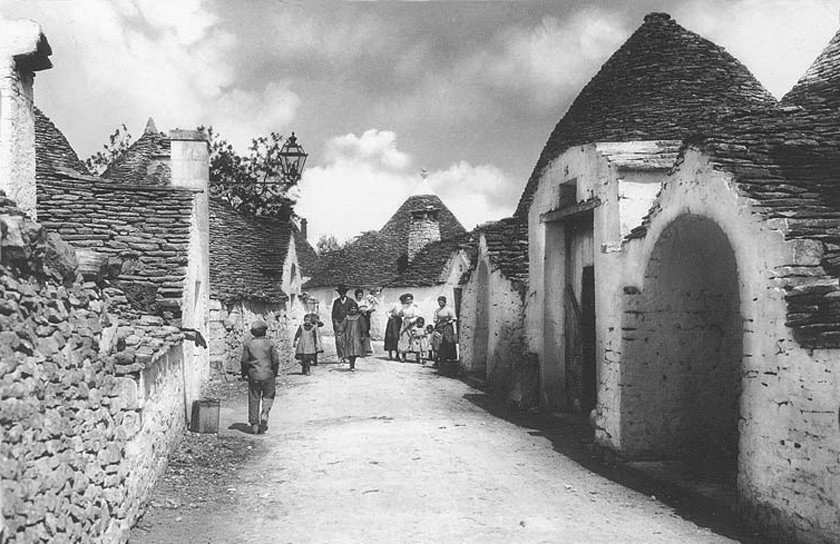 |
|
Cette photo du début du XXe siècle montre une ruelle – la rue Colombo – où
sont sortis quelques riverains – femmes et enfants principalement,
les hommes étant vraisemblablement au travail – alertés par la
présence d'un photographe. Le sol de la ruelle – faut-il dire
« sente » ? – est en terre, il n'y a pas encore de caniveaux. On
aperçoit cependant, à gauche, un bec de gaz en applique contre la
souche d'une cheminée en pierres taillées, signe du progrès de
l'éclairage public à cette époque. Sur la rive droite, on observe
deux porches d'entrée en plein cintre surmontés d'une bâtière de
lauses et, entre les deux, un large et haut portail couvert d'un
linteau en bois sous une toiture de lauses surbaissée. Une entrée
piétonne se découpe dans la grande porte en bois de ce qui est
vraisemblablement un garage à charrette (il y a un chasse-roue à
gauche). Le galbe du grand cône à droite tranche avec la
rectilinéarité du cône au pinacle blanc qu'on devine à
l'arrière-plan. Les façades sont enduites de mortier et blanchies à
la chaux (photo de provenance inconnue). |
|
This early 20th-century photo shows a narrow street – i.e. via Colombo – into which a
few residents – mostly women and children, the mensfolk being presumably out at
work – have come out on being warned of a photographer's arrival. The
revetment of the street – or lane to be precise – is earth, there is
no gutter in sight. A gas lamp is affixed to an ashlar chimney stack on the left
hand side, indicating that public lighting had already come to Alberobello at
the time. On the right-hand side, one can see two entrance porches covered by a
semi-circular vault underneath a two-sided stone roof, and in between, a tall
large cart entrance covered by a wooden lintel underneath a surbased stone roof.
A pedestrian entrance is cut out of the wide wooden door of what is presumably a
cart store as evinced by a bollard on the left. The curvilinear profile of the
large right-hand stone roof stands out in contrast to the rectilinearity of the
cone with the white pinnacle that looms in the distance. The façades are rendered
with mortar and whitewashed (photo of unknown origin). |
|
|
|
DOCUMENT 2 |
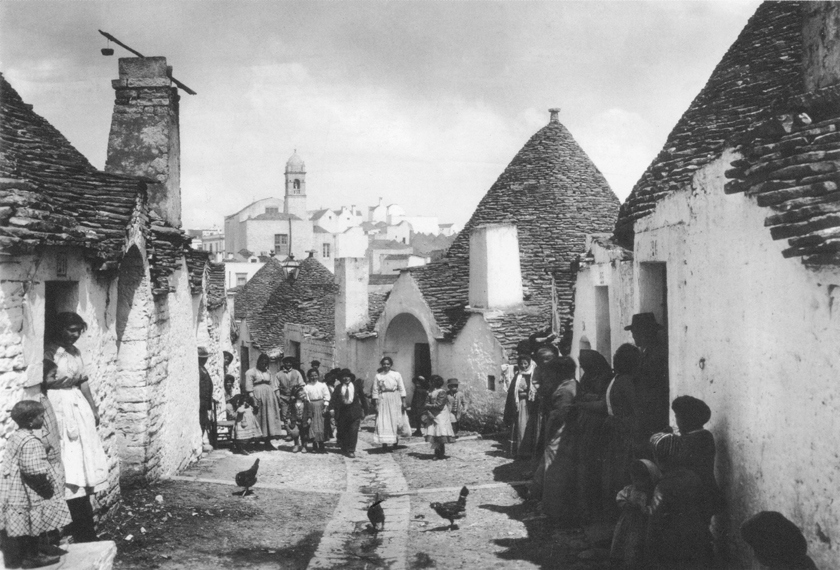 |
|
Dans la rue Monte Nero (via Monte Nero) du quartier des Monts
(rione Monti), photographiée vers 1920 par les photographes Alinari,
les habitants sont sur le pas de leur
casedda (en dialecte) ou trullo (en italien). Ici également, il y a
surtout des femmes et des enfants. Pas d'éclairage public,
d'eau courante, de tout-à-l'égout. Le sol de la ruelle est en terre et cailloutis,
avec une rigole de grandes lauses au centre. La souche de cheminée à gauche est
coiffée d'un abattant en bois qui s'abaisse ou se relève selon la direction du
vent. Certaines entrées de maisons sont coiffées d'un linteau de pierre,
d'autres sont précédées d'un petit porche couvert d'un arc en plein cintre sous
une bâtière de lauses. On admire, dans le tournant, le trullo au grand
cône curviligne précédé d'un large porche accoté d'une pièce à cheminée (photo
reproduite sur une carte postale récente). |
|
In the Monte Nero street (via Monte Nero) in the Monti district
(rione Monti) as photographed by the Alinari photographers circa 1920,
the residents are outside their casedda – in local parlance – or trullo
– in Italian. Here too, the people are mostly women and children. There
is no trace of public lighting, running water and mains drainage. The street
surface revetment is earth and gravel, with a central gutter made of large stone
slabs. The chimney stack on the left-hand side is fitted with a wooden top that
tilts up or down according to where the wind is blowing from. A number of houses
have their entrance covered by a stone lintel, others are fronted with a small
porch covered by a semi-circular vault under a two-sided stone roof. Where the
street turns, there stands out an impressive curvilinear cone fronted with a
large porch next to what appears to be a room for a fireplace (photo reprinted
in a recent postcard). |
|
|
|
DOCUMENT 3 |
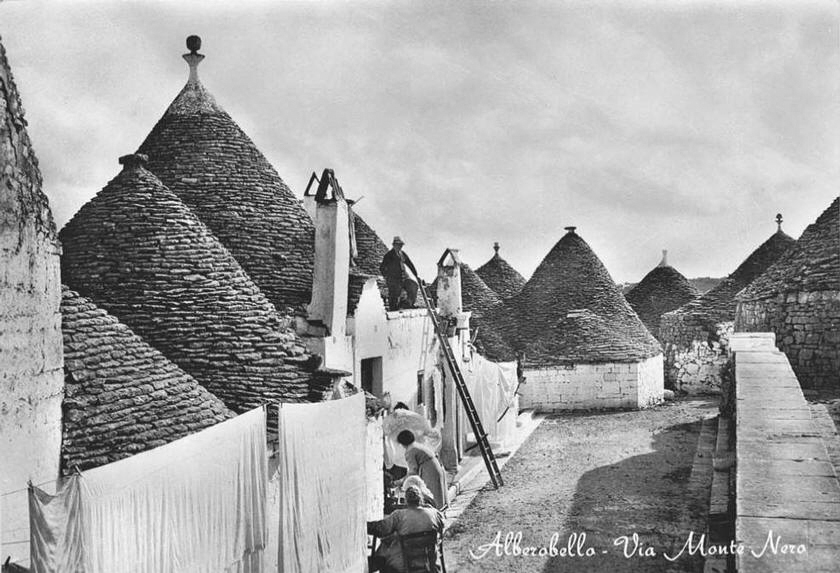 |
|
Dans cette vue prise dans les années 1950, la rue Monte Nero semble finir en
cul-de-sac (à moins qu'elle ne tourne à droite).
La voirie se résume à une chaussée de terre entre deux canivaux de
dalles. L'intérêt du document tient à l'animation qui y règne plus
qu'aux détails architecturaux qui y figurent : au premier plan, à
gauche, des draps blancs sèchent sur des fils portés par des
perches; deux femmes, assises sur des chaises, papotent tandis
qu'une troisième s'affaire (étendage du linge ?) ; un homme est
juché sur le sommet du mur-façade d'une habitation (signalée par les
souches de cheminée) : la haute échelle appuyée contre la façade
nous indique comment on monte sur les toitures des trulli (en
l'absence d'accès intérieur). Le grand cône au-dessus de la maison
est de profil rectiligne et surmonté d'un pinacle sculpté composite,
deux signes d'une construction ou d'une réfection récente. Une
bâtière de tuiles mécaniques coiffe les souches de cheminée de la
maison. À gauche de celle-ci, le petit cône curviligne terminé par un
disque de pierre est moins récent. Les hauts poteaux du fond sont ceux de
la fée électricité. |
|
In this view taken in the 1950s, the Monte Nero street seems to end
as a cul-de-sac (although a right turn is not to be ruled out). The road surface
consists only of earth between two slab-built gutters. The document's interest
lies not so much in the animated scene that is depicted in it as in the
architectural details that are featured in it: in the foreground, on the left,
white sheets are hung out to dry on a clothes line held up by perches; two women
sitting outside are having a chat while a third one is busy hanging out the
washing (?); a man is perched on top of the façade wall of a house (with its
telltale smokestack); the tall ladder leaning against the façade points to the
way trullo roofs are accessed (for lack of inside access). The large cone
roof above the house boasts a rectilinear profile and a composite carved
pinnacle, two features indicative of recent construction or restoration. The
chimney stacks are capped with opposite machine-made tiles. To the left of the
house, the small curvilinear cone roof topped by a stone disk is of a later
date. The tall poles in the background are electricity poles (courtesy of the
Electricity Fairy). |
|
|
|
DOCUMENT 3 - détail |
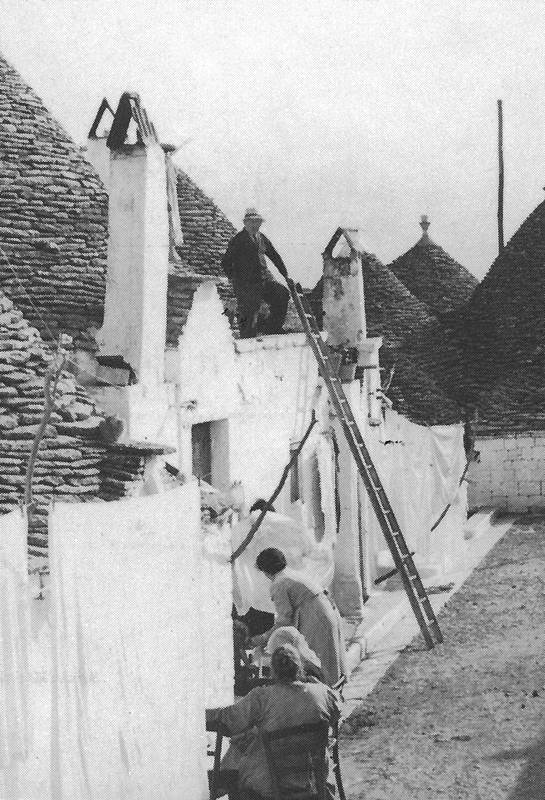 |
|
Agrandissement de la scène animée devant la maison. |
|
|
Zooming in on the animated scene outside the house. |
|
|
|
|
DOCUMENT 4 |
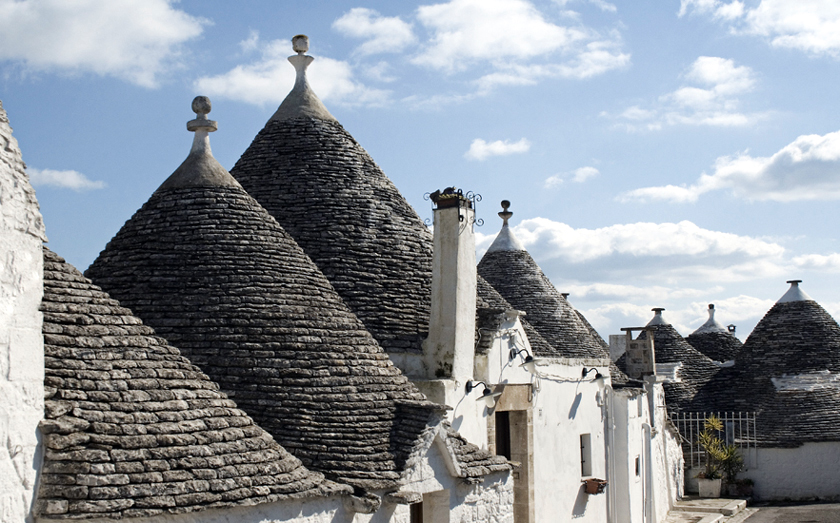 |
|
Le même
emplacement au milieu des années 2000. On remarque que le haut du conduit de
cheminée est occupé non plus par une mitre mais par un dispositif
agrémenté de ferronneries (?). Les deux autres conduits en arrière ont disparu
mais un nouveau conduit est apparu au-dessus de la façade de la maison en bout.
On note également que des symboles ont été badigeonnés sur le devant de deux
cônes (alors qu'il n'y en avait pas du tout dans les années 1950) et qu'ils
commencent à s'estomper. Au sommet du deuxième cône à partir de la gauche de
l'image, le disque de pierre qui formait le pinacle s'est vu gratifié d'un
piètement plus svelte et couronné d'une boule sur pied. Tout au fond de
l'impasse, une grille est venue fermer un espace privatif. Enfin, la façade de
la maison à l'échelle des années 1950 dispose de trois lampes en applique pour
l'éclairage nocturne. (Cette photo est tirée de la page intitulée «
Les Pouilles, pays des trulli », du site «
Plaisirs, gastronomie et voyages »). |
|
The same row in the mid-2000s. A strange device with
wrought-iron fittings has been substituted for the mitre at the top of the tall
chimney stack. The other two chimney stacks that stood behind it have vanished
while a new one has sprung up above the front wall of the house at the far end
of the row. Two of the roof cones boast a whitewashed, albeit faded, symbol
(they did not have any in the 1950s). At the top of the second cone from the
left of the picture, the initial stone disk finial has acquired a more slender
base and serves as a support for a ball. At the far end of the cul-de-sac, a
private area has been shut off by metal railings. Finally, the front of the
house with the ladder (in the 1950s postcard) has been fitted with three
wall-mounted electric lamps for nighttime lighting. (This photo originates from
a page entitled "Les Pouilles, pays des trulli", in the "Plaisirs,
gastronomie et voyages" website). |
|
|
|
DOCUMENT 5 |
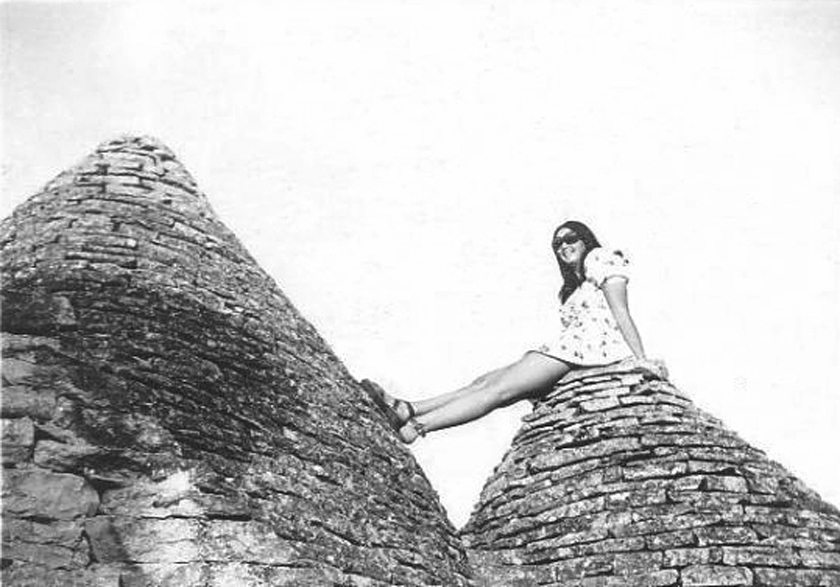 |
|
Il ne
faut pas s'imaginer que tous les cônes de trullo se terminent par un
pinacle sculpté ; il en est certains qui sont coiffés simplement d'une grande
dalle circulaire, à laquelle on peut accéder par une volée de marches réservées
dans l'épaisseur de la couverture de lauses. Sans cette configuration, cette
ingambe demoiselle des années années 1960 n'aurait pas trouvé de perchoir où se jucher
pour les besoins de la photo (photo en attente d'identification). |
|
It would be vain to believe that all trullo cones are capped
with a carved pinnacle; some of them are crowned simply by a large circular
slab, access to which is by a flight of steps built into the stone roof. But for
the steps and slab, the agile young lady in the picture would not have made it
to the top and sat on the crowning slab for a photo op. (photo origin: pending
identification). |
|
|
Pour imprimer, passer en mode paysage
To print, use landscape mode
© CERAV
La présente page est susceptible d'être modifiée /
This page remains subject to additional edits
Le 5 janvier 2011 / January 5th, 2011 - complété le
8 janvier 2011 - 20 janvier 2011 - 12 février 2011 - 22 juin 2011 - 6 mars 2018 /
Augmented on January 8,
2011 - January 20th, 2011 - February 12th, 2011 - June 22nd, 2011 - March 6th,
2018
Référence à citer / To be referenced as :
Christian Lassure
Série
Les trulli ou casedde d'Alberobello (province de Bari, Italie) à
travers les cartes postales et photos anciennes (Series: The trulli or casedde
of Alberobello, province of Bari, Italy, through old postcards and photos)
(version bilingue français-anglais)
II - Photos de la première moitié du XXe siècle (Photos of the first half of the 20th
century)
http://www.pierreseche.com/alberobello_photos.htm
5 janvier 2011
I - Les trulli. Résumé historique et architectural
Trulli. A historical and
architectural summary
II -
Photos de la première moitié du XXe siècle
Photos of the first half of the 20th century
III -
Les
avatars de la rue Monte Pertica au quartier Monti (1950-2010)
The changing face of via Monte Pertica in the Monti district (1950-2010)
IV -
L'hôtel des
trulli
The Hotel of the Trulli
V - Rione Monti, via Monte Santo
VI - Rione Monti, via Monte Sabotino
VIII - Rione Monti, via Monte Nero
(en construction)
IX - Rione Monti, via Monte Pasubio
(en construction)
X - Rione Monti, via Monte San Gabriele
XI - Rione Monti, via Duca d'Aosta
XII - Rione Monti, piazza d'Annunzio
(en construction)
XIII - Rione Monti, vico d'Annunzio
(en construction)
XIV - Rione Monti, Chiesa de Sant' Antonio
XV - Rione Monti, panorama della zona monumentale "Principe de
Piemonte" (en construction)
XVI - Rione Aia Piccola, piazza Plebiscito
XVII - Rione Aia Piccola, via Giuseppe Verdi
(en construction)
XVIII - Rione Aia Piccola, via Duca degli Abruzzi
XIX - Rione Aia Piccola, via Galilei
XX - Il Trullo Sovrano
(en construction)
XXI - Via Monte Calvario
XXII - Via Monte Grappa
(en construction)
page d'accueil
home page
|






